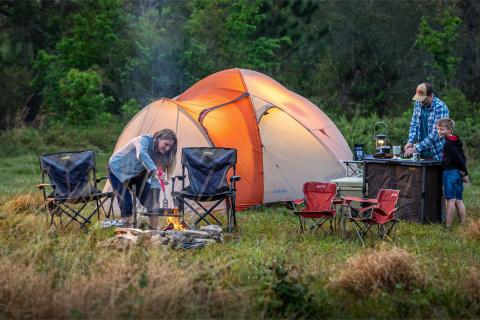
This camping guide will be covering the basics of how to camp, focusing on the essential camping gear you'll want for a memorable outdoor experience.
4 Things to Plan for the Best Camping Trip
 1. Plan for the weather. Is there a chance of rain and flooding? What are the high and low temperatures expected? Packing is dependent on the answers to these questions.
1. Plan for the weather. Is there a chance of rain and flooding? What are the high and low temperatures expected? Packing is dependent on the answers to these questions.
2. Research the campground. Gain knowledge of the location in which you will be camping, create a list of camp host questions. Start by visiting the campground website and reading the reviews. Or, use the phone number to call the property managers or camp host, or perhaps the site has a chat feature where you can ask questions. Another suggestion; use the contact us link that most websites offer. And, if you know someone who has visited the site, they should behave a wealth of knowledge.
Before choosing your campsite within the campground, scope out the area if possible. Where are the amenities? How close are you to water, restroom, and other campers?
are you to water, restroom, and other campers?
Tip: Printable - Checklist of question to ask a camp host before you book a camping spot
Here are 15 questions to ask the campground host. You may have others that may come to mind.
- Is the campground a family vacation spot or adult preferred?
- If family oriented, is there a quiet time curfew?
- Are there marked trails?
- Does the campground provide electricity?
- Are pets allowed?
- Will the camp host be on site for questions and support?
- What time is check out?
- How far will my campsite be from other campers?
- Can I build a campfire?
- Does the campground provide firewood for purchase or is it free?
- Will there be enough firewood available or should I bring my own?
- What amenities are available at the campground?
- Are there any planned activities?
- Is there a shopping center or grocery store at the park or nearby?
- How far is the closest hospital or emergency room?

Tip: Dontmovefirewood.org recommends you only use wood cut within 50 miles of where you’re burning it to prevent the spread of invasive insects or disease.
Tip: The 7 Principles of Leave No Trace (video)
3. Share the Camp Plans With Someone. Always make sure someone knows where you will be staying and the route you will be driving or hiking to the campsite. Letting someone know is essential just in case you were to get lost or hurt; someone would know where to begin looking.
4. Plan Your Organized Packing. Begin by asking yourself a few questions such as: How long are you are staying? What kind of weather to expect? What activities are you planning for the trip and where? Questions like these will help you determine what you need to pack and how much to pack for food, water, clothing and shelter. Camping equipment needs to be considered too. Your best bet is to plan for all kinds of camping weather, know the conditions of where you're going, and get updates frequently.
How and What to Organize for a Camp Trip
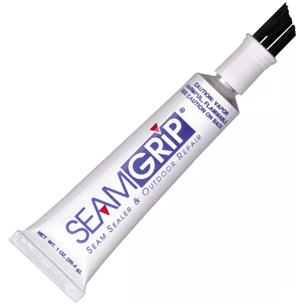
Seam Sealer with Brush
Applicator
When camping, you will want to make a list and then organize your items for ease of finding in waterproof containers. Labeled storage tubs work well.
Camping Gear – What will you need to protect yourself in all kinds of weather?
- Tent and Tarp
- Weather Radio
- Sleeping Bag
- Waterproof Bags
- Tenacious Tape Repair Patches
- Camp Furniture
- McNett Seam Grip Sealer Repair

Stove
Cooking - What will you eat at camp, and how will you fix it?
- Coolers
- Cleaning Supplies
- Camp Cookware
- Food
- Camp Stove or grill
Safety - What will you need at camp to keep you or your family safe?
- Lighting / Headlamps
- Sunscreen
- Survival Gear and First Aid Kit
- Insect Repellent
- Water Filters and Water Purification

Tip: Print out a camping checklist PDF here, then check items off the checklist while you load up.
6 Adaptable Types of Camp Shelters
You will need is a place to sleep that will protect you from the weather and insects as you experience the outdoors.
Primitive Shelters - made from trees, brush, leaves, and grasses. These types of accommodations have become popular on survival television shows. What is a Primitive Campsite? - Another term for boondocking, wilderness, backcountry and dispersed camping. A primitive campsite allows people to enjoy the solitude and primitive experience of camping away from developed campgrounds and other campers. Primitive campgrounds typically do not have amenities and do have strenuous trails.
Read: Important Things About Dispersed Camping on Public Land

the Ozark Mountains, Ridgedale, Missouri.
RV Campers - pop up campers to large 5th wheel campers. This form of camping has become extremely popular and continues to increase. Some call it Glamping; Glamorous camping.
Glamping - The difference in camping, although slight, is in the level of comfort you choose to seek. For example, camping accommodations can be under the stars, a tent, a trailer, or an RV. Glamping accommodations can be the same, and you can probably add tent, treehouse, yurt, and cabin to the list for glampers.
Read: How do You Know if You're Camping or Glamping.

Hammock Camping - has also been increasing in popularity. It is best done during the summer months when the weather is dry. When purchasing a hammock, don't forget a bug net like the Eagles Nest Outfitters Guardian Bug Net, to give you bite-free peace of mind.
Read: 6 Tips for Winter Hammock Camping (video)
Tent Camping - the most common form of shelter while camping is a tent. While tent camping, you need to choose your campsite carefully. A level site free of debris, branches, rocks, and plant life will protect your tent floor from holes and keep anything from poking you while you sleep. The purchase of a good ground cloth like Big Agnes Big House 4 Tent Footprint Ground Cloth will protect your tent for years.
Tip: Avoid setting up your tent at a low spot in the landscape. Water run-off from rain will pool in low areas as well as cold air and make for miserable night's sleep.

The Bass Pro Shops Eclipse Dome Tent is a great weekend camping tent for the whole family, providing performance without emptying your wallet. This tent comes in a variety of sizes, depending on how many people are camping with you. When purchasing a tent, it is recommended that you choose a tent large enough to fit two additional people. This will give you more room if it rains, and you have to spend the day inside and also for cots and clothing totes.
The Eclipse Dome Tent Features Include: Lightweight and packable tent at a great value, sturdy, shock-corded fiberglass-pole frame, sturdy walls and rainfly – 190T polyester taffeta with an 800mm polyurethane coating, tough and waterproof polyethylene tarp floor, ventilating no-see-um mesh panels in the roof and door, interior gear loft and organization pocket.
 Tents are flammable, so make sure you set it up away from your campfire or camp stoves or any other fire source.
Tents are flammable, so make sure you set it up away from your campfire or camp stoves or any other fire source.
Before heading out, you should practice setting up your tent in the backyard to verify all of the parts, including stakes, rainfly, ground cloth, and poles are in good shape and included. Practicing setting up the tent will make for a less stressful camp set up. Dome shaped tents like the Cabela's West Wind 6-Person Dome tent are top-rated for families and one of the easiest to put up.
If You are Thinking of Buying a Tent, Use These Tips From Our Experts
- Always add 2 people to your group when picking a tent size.
- Full mesh tents are ideal for hot weather camping, but having a rain fly in reserve gives peace of mind.
- 2 pole tents will be much easier to set up than more complex designs.
- It's never a bad idea to set your tent up prior to camping. This will help ensure an easy setup at camp, just remember to make sure all surfaces are dry before packing it up to prevent mold and mildew.
- A separate room for gear offers many advantages - definitely an option worth the price.
Tip: How to Maximize Space in a Camping Tent
Get more helpful tent buying tips, read "Buying a Tent? Here's a Guide to Make the Perfect Choice".
Getting Peaceful Sleep at Camp
Sleeping bags - will keep you warm during the night. Sleeping bags come with a temperature rating, so it is essential when choosing that you have some idea of what the low temperatures will be each night. Sleeping bags will keep you warm, but for comfort, you will want to add a sleeping pad, or camp cot, or air bed.
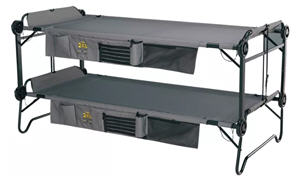
Disc-O-Bed
Sleeping pad, Air Mattress, Camp Cot - each of these has pros and cons; you will have more comfort with camp cots or an air bed, but they are larger, heavier, and harder to haul than a sleeping pad.
Tip: Shop Air Mattress, Air Beds & Camping Cots here
A camp cot raises you off the ground. Elevation helps with air circulation to keep you cool in hot conditions; it also separates you from its chill in cool weather. Cots come is all sizes such as extra large and bunk beds like the Cabela's 2XL Outfitter Bunk Bed by Disc-O-Bed.
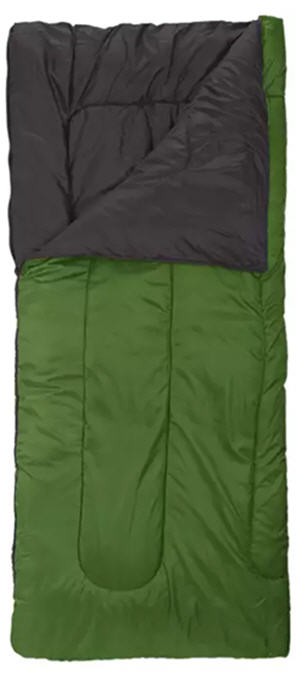
Hawksbill 40º Rectangular
Sleeping Bag
Tip: Which is Right for You: Air Mattress, Sleeping Pad or Camp Cot?
A great sleeping bag for milder weather campouts in your tent or for sleeping under the stars, the Bass Pro Shops Eclipse Hawksbill 40° Rectangular Sleeping Bag keeps you comfortable without making you sweat. Sleeping bag features: 40º comfort rating, Lightweight 3 lb. 12 oz. bag, Polyester shell with polyester liner, 3 lbs. of polyester insulation, 2 bags can zip together to form a double sleeping bag.
Camp Furniture - The type of camping you do determines the type of camp furniture you'll want. Some campers want a chair that is lightweight and easy to transport. For family campers, having camp chairs and a folding table provides easy seating and food prep space.
Fun Easy Cooking at Camp
Cooking at camp can be done on a stove, smoker, grill, or over a campfire. Whether you need a camp stove, smoker, or grill, Bass Pro/Cabelas has lots of products to choose from.

Once you determine your cooking source, you will need to gather all of your camp cookware and utensils, pots, pans, tongs, cutting boards, knives, etc. Think about your kitchen and all of the cookware and eating utensils you use at home daily. Do remember to scale your cookware to the type of camping trip you're planning. For example, for backpacking the Ascend 3-Piece Backpack Cook Set is made of lightweight aluminum and weighs only 12.7 oz. For family camping, the popular Cabela's Cast-Iron 5-Piece Starter Set offers everything you need to start enjoying cast iron cooking

Next, where will you prepare your food? Your working surface needs to be easily cleaned and large enough to hold everything. Camp folding tables like Bass Pro Shops Medium Folding Camp Table are a great choice as they can be packed and moved quickly.
Refrigeration, keeping your food cold is essential, especially during the hot summer months. The last thing you want is your food to spoil and ruin. The weather, number of people, and how many meals you will be providing will determine your refrigeration needs. Camping coolers are the go-to refrigeration source as they don’t need electricity.
Now that you have your cooking supplies and equipment, you need food. When considering the food, you need to know whether you are backpacking into a location or camping in an accessible campground.
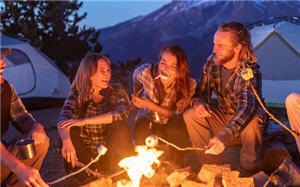 Common choices for backpackers are high nutrients lightweight freeze-dried foods (dehydrated fruits and beef jerky) with them, so they do not have to cook. While in a campground setting, you can prepare a Thanksgiving dinner with some planning.
Common choices for backpackers are high nutrients lightweight freeze-dried foods (dehydrated fruits and beef jerky) with them, so they do not have to cook. While in a campground setting, you can prepare a Thanksgiving dinner with some planning.
Lastly, once dinner is made, you will need cleaning supplies to clean up just like you do at home. Dish soap, rags, sponges, and a container to wash dishes should do the trick.
If interested in learning more about camp cooking, check out the Camp Cooking presentation.
Other Camp Items to Make Your Trip Successful and Safe
The Camp Light Source
Our eyes are not made to see in the dark, so while camping, you will need to bring extra lighting. Lighting can include lanterns, flashlights, and headlamps.
Lanterns - come in many different sizes and kinds from electric or battery-powered, fuel burning and even candle
Flashlights - are smaller and are electric or battery-powered with lots of sizes
Headlamps - are worn on your head and put off the least amount of light.
Each of these lights has benefits and disadvantages; for instance, lanterns put off lots of light for a large area, but are bulky to carry around. Best use is to hang them or set them on a table to create a large area of light.
Headlamps allow you to move around without worrying about carrying something, but the level of light is much less than a lantern. Best use is when trying to complete a task like cooking or finding something they allow you to continue to complete the job without worrying about dropping the light source.
Read: 7 Reasons You Should Use Solar Power to Charge Your Electronics
Camping Protection Items
There is no such thing as being too careful and remaining safe while outdoors is essential as lots of the areas in which you hike have limited access to emergency services. Shop survival items for outdoor safety like Coghlan's Magnesium Fire Starter, A smart tool for any campout or hike into the outdoors. Also, having a whistle for emergency calls is essential, especially one that has six functions like the Coghlan's Safety Whistles. This whistle comes with LED light, compass, magnifier, thermometer, signal mirror and whistle – all attached to a lanyard with a convenient clip can be used for boating, camping, hiking, hunting or anytime you need help.
Never forget a first aid kit, Bass Pro Shops has a great selection of survival gear and first aid kits that help in many emergencies such as the Bass Pro Shops Backpacker First Aid Kit or a Day Hiker First Aid Kit.
Our Cabela's stores also offer a variety of outdoor safety and survival gear to ensure that you're prepared at all times.
Tip: Print out a camping checklist PDF here, then check off items on the checklist while you load up.
Watch video: 6 Tips for Camping Like A Pro
Where to Find Your Camping Vacation or Next Hiking Getaway
Most state parks as well as national parks allow visitors to fish, camp and hike and some regulated allow hunting.
There are 419 national park sites in the United States encompassing more than 84 million acres and 10,234 state parks.
These parks are owned by all Americans and are set aside and protected so that we may enjoy these places for years to come. The chances are that there is a park close to where you live. Recreation.gov is a great website to use to find information on national and state parks. Or, for more information, go to your state wildlife or state conservation agency 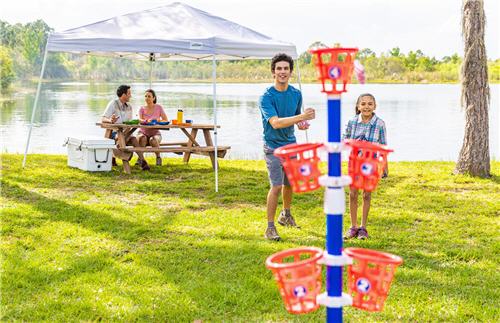 website.
website.
Fun Family Games & Activities for Campers
Plan for your family to stay where they will fully enjoy their time together. After all, camping is supposed to be fun.
Shop Outdoor Games and toys here
Camping with the family can be a fantastic experience; here are some ideas to engage the kids in activities that will keep them motivated while camping.
- 10535 views

